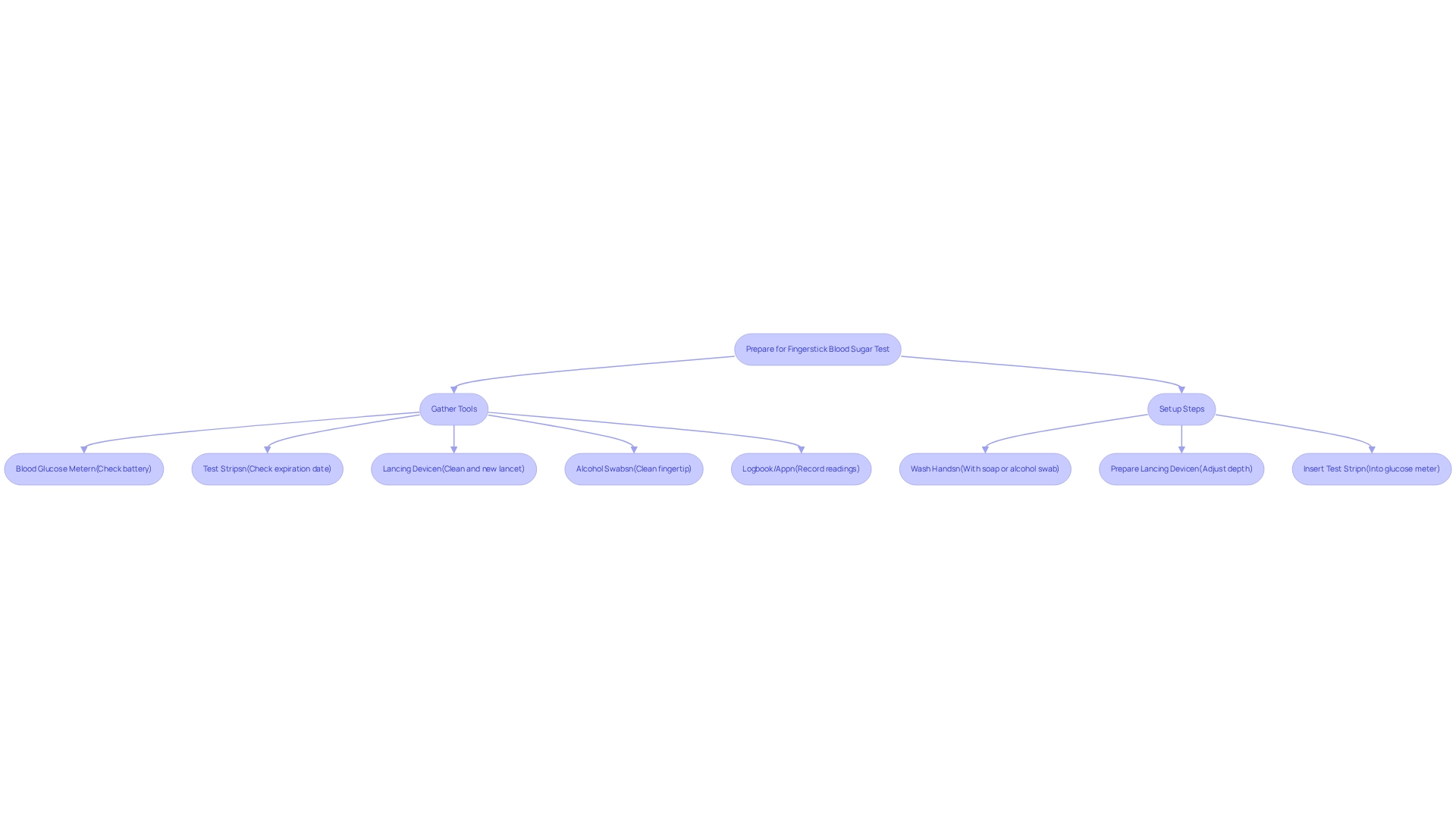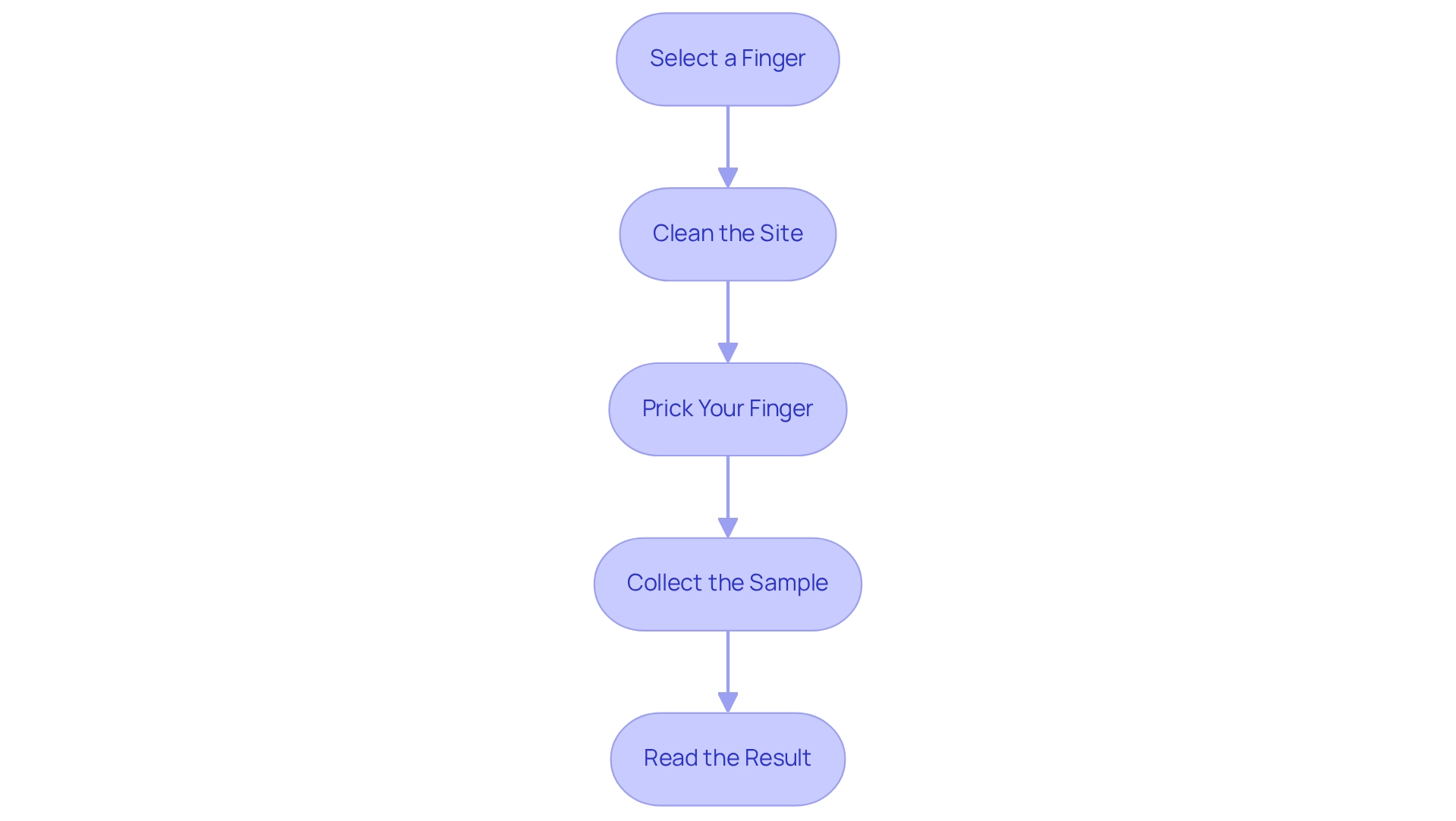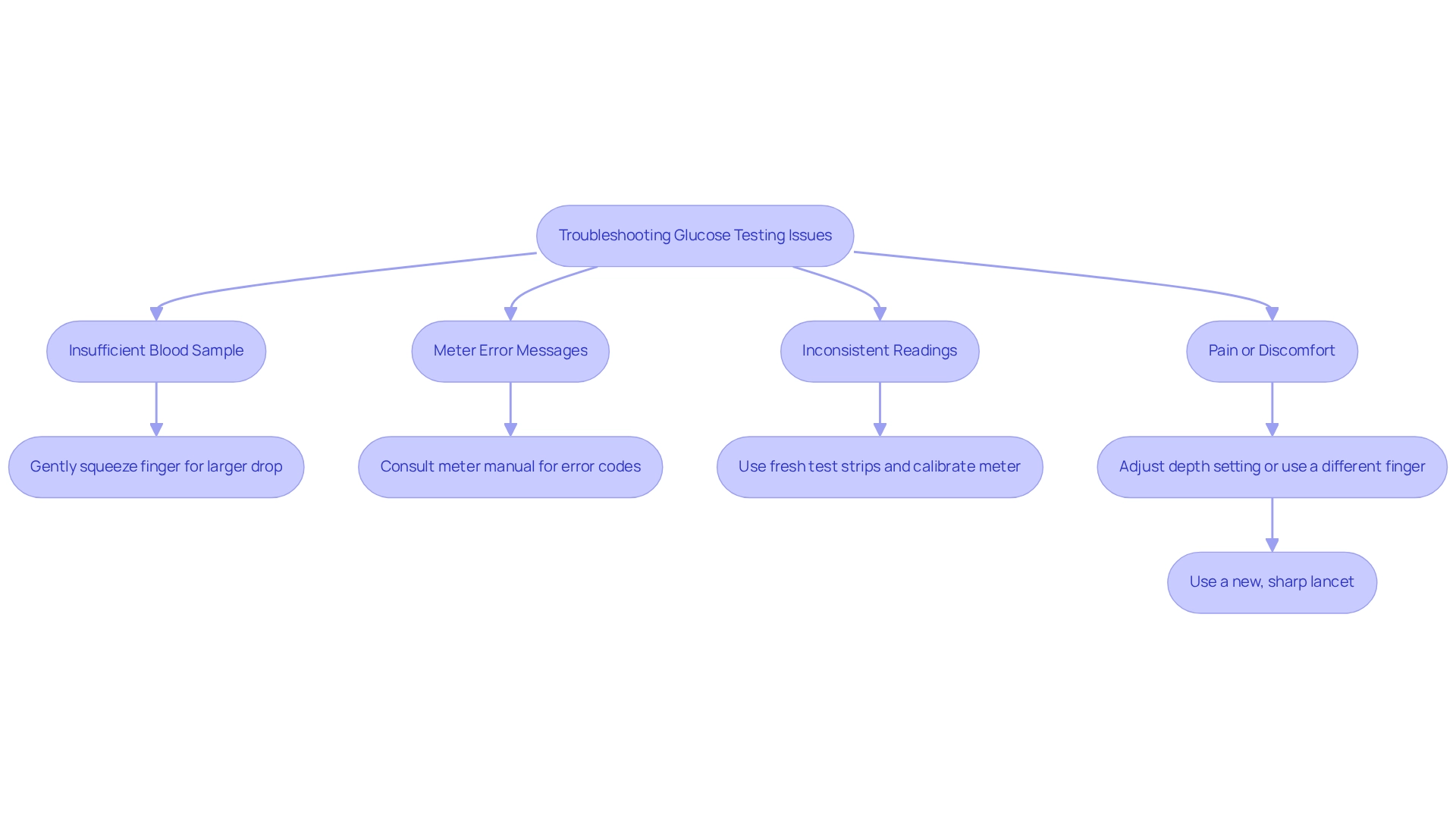Overview
This article is dedicated to helping you master fingerstick blood sugar testing, guiding you through a four-step process to effectively monitor your glucose levels. It’s important to recognize that proper preparation, execution, and troubleshooting are essential for enhancing testing accuracy and managing diabetes effectively. Many patients find that by focusing on these aspects, they can significantly improve their health outcomes.
We understand that managing diabetes can be challenging, and the journey often feels overwhelming. That’s why we share patient experiences and expert recommendations, highlighting the critical role of consistent monitoring in achieving better health. By embracing this process, you can take meaningful steps toward a healthier lifestyle.
Remember, you’re not alone in this journey. With the right tools and support, you can navigate the complexities of diabetes management. As you delve into this article, consider how these insights can empower you to take charge of your health and well-being.
Introduction
In the journey of managing diabetes, fingerstick blood sugar testing stands out as a vital companion for individuals, especially those navigating the complexities of type 2 diabetes. This straightforward yet powerful method enables regular monitoring of blood glucose levels, empowering patients to make informed decisions about their diet, exercise, and medication. It’s important to recognize that as technology advances, the accessibility of testing improves, leading more patients to weave this practice into their daily routines and enjoy the benefits of enhanced health outcomes.
However, many patients find that the process is not without its hurdles. Understanding potential inaccuracies and troubleshooting common issues is crucial for effective management. With expert insights and practical strategies, patients can transform fingerstick testing from a routine task into a powerful tool for reclaiming their health and well-being. Remember, you are not alone on this journey; support and knowledge can make all the difference.
Understand Fingerstick Blood Sugar Testing
Fingerstick blood sugar testing is an essential tool for individuals managing diabetes, especially for those with type 2 diabetes. This technique involves pricking the fingertip to collect a small sample, which is then analyzed to assess glucose levels. Consistent monitoring is essential, as it empowers individuals to understand how their diet, exercise, and medications influence their sugar levels. This understanding enables timely adjustments to treatment plans and lifestyle choices.
At Integrative Wellness Center, led by Dr. Jason Shumard, D.C., who brings nearly 20 years of experience in helping patients reverse type 2 diabetes, we emphasize a personalized approach to managing this condition. Here, fingerstick blood sugar assessments play a crucial role. Recent advancements in monitoring technology have made fingerstick procedures more accessible and user-friendly. Many patients now incorporate fingerstick blood sugar testing into their daily routines, which highlights its effectiveness in enhancing diabetes control. Reports indicate that those who regularly track their blood sugar levels experience better management of their condition, leading to improved health outcomes.
It’s important to recognize that certain medical treatments and substances can affect sugar readings. For example, a patient receiving intravenous immunoglobulin formulations containing maltose recorded capillary sugar readings of 167 and 439 mg/dl, while laboratory-measured venous plasma sugar levels were only 41 and 187 mg/dl. This serves as a reminder of the potential inaccuracies in sugar level readings and underscores the importance of precise monitoring techniques.
Moreover, specialists emphasize the significance of regular glucose monitoring. Diabetes experts assert that understanding sugar level fluctuations allows patients to make informed decisions about their health. Dr. Jason Shumard states, “By providing patients with actionable insights and practical tools, the center fosters an environment where individuals can reclaim their health and well-being.” This proactive approach not only boosts patient engagement but also nurtures a sense of control over their diabetes management.
Real-world experiences illustrate the positive impact of fingerstick blood sugar testing. One patient shared, “Since I started monitoring my blood sugar regularly, I’ve been able to adjust my diet and exercise, leading to significant improvements in my A1C levels.” Many patients report substantial enhancements in their ability to manage their condition effectively, thanks to the insights gained from regular monitoring. These stories reinforce the idea that fingerstick blood sugar testing is not merely a routine task; it is a vital element of a comprehensive diabetes management strategy. Patients are encouraged to consult their healthcare provider to identify the most suitable glucose monitoring method for their lifestyle, ensuring personalized care.
Prepare for the Test: Tools and Setup
To conduct a fingerstick blood sugar test effectively, it’s essential to gather the following tools that can enhance the accuracy and smoothness of your testing experience:
- Blood Glucose Meter: Ensure it is functioning properly and equipped with fresh batteries.
- Test Strips: Use strips compatible with your meter, checking the expiration date to ensure accuracy.
- Lancing Device: This device holds a lancet for pricking your finger. Make sure it is clean and contains a new lancet.
- Alcohol Swabs: For cleaning the fingertip before examination, maintaining hygiene is crucial.
- Logbook or App: To record your sugar readings, facilitating better management of your diabetes.
Setup Steps:
- Begin by washing your hands thoroughly with soap and water, or use an alcohol swab to clean the fingertip you plan to use.
- Prepare your lancing device according to the manufacturer’s instructions, adjusting the depth setting for comfort.
- Insert a test strip into the glucose meter, ensuring it is ready for use.
It’s important to recognize that incorporating a holistic approach to diabetes management can significantly enhance your testing routine. Many patients find that participating in consistent outdoor activities, like walking or hiking in the picturesque parks of San Marcos, can improve insulin sensitivity and support stable sugar levels. Additionally, focusing on a balanced diet abundant in local produce, such as avocados and berries, promotes overall health and assists in sugar regulation, particularly for those who monitor their fingerstick blood sugar levels, emphasizing the significance of correct configuration and application. Readings exceeding 180 mg/dL suggest hyperglycemia, highlighting the necessity for precise evaluation. In 2025, the most common tools for blood glucose measurement include advanced meters that offer connectivity features, enhancing data tracking and management.
Healthcare professionals recommend maintaining good hygiene and testing practices to improve the overall testing experience. This practice not only enhances accuracy but also comfort. Furthermore, consider exploring local community programs in San Marcos that provide support and resources for managing blood sugar levels, such as nutrition workshops or fitness classes. Staying informed about the latest tools available for diabetes management is essential for optimizing your health journey.
Perform the Fingerstick Blood Sugar Test
To perform your fingerstick blood sugar test accurately, it’s essential to follow these steps with care:
- Select a Finger: Choose a finger that feels comfortable and is free from soreness or calluses. The sides of your fingertips are often less sensitive and ideal for testing.
- Clean the Site: Gently disinfect the area where you will prick your finger using an alcohol swab. Allow it to dry completely; this helps minimize discomfort during the test.
- Prick Your Finger: Position the lancing device against the side of your fingertip, and press the button to release the lancet. Expect a quick pinch as the device punctures the skin.
- Collect the Sample: Gently squeeze your finger from the base to encourage a drop of fluid to form. Touch the edge of the test strip to the drop of fluid, allowing it to be absorbed effectively.
- Read the Result: Wait for the meter to display your blood sugar level. Be sure to record the result in your logbook or app for future reference.
It’s important to recognize that understanding the precision of your evaluation method is crucial. Research suggests that the type of test strip used can significantly influence measurement accuracy; some strips may be more susceptible to interference from other sugars. For instance, Adam’s CV of 41% indicates that he experienced more fluctuations in blood sugar throughout the day, underscoring the importance of precise testing in managing your condition. Therefore, using reliable glucose measurement technology, such as Accu-Chek glucose strips and meters, is vital for obtaining accurate results.
Many patients find that by adhering to these guidelines, they can successfully conduct fingerstick blood sugar tests, which leads to improved management of their diabetes. To enhance your health journey, consider establishing SMART goals related to your glucose monitoring. For example, you might aim to assess your levels at the same time each day, monitor your outcomes weekly with a fitness app or journal, or gradually increase your assessment frequency to recognize trends. As Dr. Jason Shumard wisely states, “By providing patients with actionable insights and practical tools, the center fosters an environment where individuals can reclaim their health and well-being.” Additionally, you can download a free A1C chart to convert A1C and glucose levels, further enhancing your understanding of your condition and treatment options. By following these steps and incorporating goal-setting into your routine, you can ensure that your evaluation process is both effective and efficient, ultimately empowering you to take control of your health.
Troubleshoot Common Testing Issues
When evaluating your glucose levels, you may encounter various challenges that can feel daunting. It’s important to recognize that you’re not alone in this journey. Here are some effective troubleshooting tips to help you navigate common problems:
- Insufficient Blood Sample: If your meter indicates that there isn’t enough blood, gently squeeze your finger to produce a larger drop. Be cautious not to squeeze too hard, as this can compromise the accuracy of your reading.
- Meter Error Messages: Many patients find it helpful to consult their meter’s manual for guidance on specific error codes. Common issues include incorrectly placed test strips or low battery notifications, which can interfere with your evaluation process.
- Inconsistent Readings: Significant fluctuations in your readings may signal a problem. Ensure you are using fresh test strips and that your meter is properly calibrated. Always check the expiration dates on your strips to avoid inaccuracies.
- Pain or Discomfort: If you experience pain during the fingerstick blood sugar test, consider adjusting the depth setting on your lancing device or using a different finger. Always use a new, sharp lancet to minimize discomfort.
Statistics suggest that around 30% of individuals with blood sugar issues encounter measurement errors, frequently due to these typical problems. For instance, a case study highlighted a patient who improved their testing accuracy by implementing these troubleshooting strategies, leading to better overall management of their condition. Dr. Jason Shumard emphasizes, “By providing patients with actionable insights and practical tools, the center fosters an environment where individuals can reclaim their health and well-being, ultimately leading to improved quality of life and reduced reliance on conventional medical interventions.”
Incorporating holistic health solutions, such as engaging in regular outdoor activities and maintaining a balanced diet rich in local produce, can further enhance your management of the condition. Furthermore, taking part in community wellness initiatives can offer essential assistance and resources tailored for effectively managing blood sugar levels. By implementing these troubleshooting strategies alongside lifestyle changes, you can enhance your testing accuracy and overall diabetes management. Understanding health literacy and culturally competent care can further empower you in your self-management efforts.
Conclusion
Regular fingerstick blood sugar testing is truly a cornerstone of effective diabetes management, especially for those navigating the challenges of type 2 diabetes. This method not only offers crucial insights into how diet, exercise, and medications influence blood sugar levels but also empowers patients like you to make informed decisions about your health. With advancements in technology, what once felt like a daunting task has become more accessible, leading to better health outcomes for many individuals.
However, it’s important to recognize the potential challenges associated with fingerstick testing, such as inaccuracies that can arise from various factors. Many patients find that understanding these issues and employing practical troubleshooting strategies can transform the testing process from a routine obligation into a powerful tool for health management. By consistently monitoring blood glucose levels and being proactive in addressing any concerns, you can significantly enhance your diabetes control and overall well-being.
Ultimately, fingerstick blood sugar testing is more than just a means of tracking numbers; it is a vital component of a comprehensive diabetes management strategy. Embracing this practice, alongside personalized care and support from healthcare professionals, can lead to an improved quality of life and a greater sense of control over your health journey. Empowerment through knowledge and consistent monitoring is key to successfully navigating the complexities of diabetes, allowing you to reclaim your health and truly thrive.
Frequently Asked Questions
What is fingerstick blood sugar testing?
Fingerstick blood sugar testing is a method used to collect a small blood sample from the fingertip to assess glucose levels, which is essential for individuals managing diabetes, particularly those with type 2 diabetes.
Why is consistent monitoring of blood sugar levels important?
Consistent monitoring empowers individuals to understand how their diet, exercise, and medications affect their sugar levels, allowing for timely adjustments to treatment plans and lifestyle choices.
How has technology impacted fingerstick blood sugar testing?
Recent advancements in monitoring technology have made fingerstick procedures more accessible and user-friendly, enabling many patients to incorporate blood sugar testing into their daily routines.
What are the benefits of regular blood sugar monitoring?
Regular tracking of blood sugar levels leads to better management of diabetes, resulting in improved health outcomes for patients.
Can medical treatments affect blood sugar readings?
Yes, certain medical treatments and substances can influence sugar readings. For example, intravenous immunoglobulin formulations containing maltose can lead to inaccurate capillary sugar readings compared to laboratory-measured venous plasma sugar levels.
What do diabetes experts say about glucose monitoring?
Diabetes experts emphasize that understanding sugar level fluctuations allows patients to make informed health decisions, enhancing patient engagement and control over their diabetes management.
How have patients benefited from fingerstick blood sugar testing?
Patients who regularly monitor their blood sugar report significant improvements in their ability to manage their condition, including adjustments to diet and exercise that lead to better A1C levels.
What should patients do to find the best glucose monitoring method for themselves?
Patients are encouraged to consult their healthcare provider to determine the most suitable glucose monitoring method that fits their lifestyle, ensuring personalized care.


